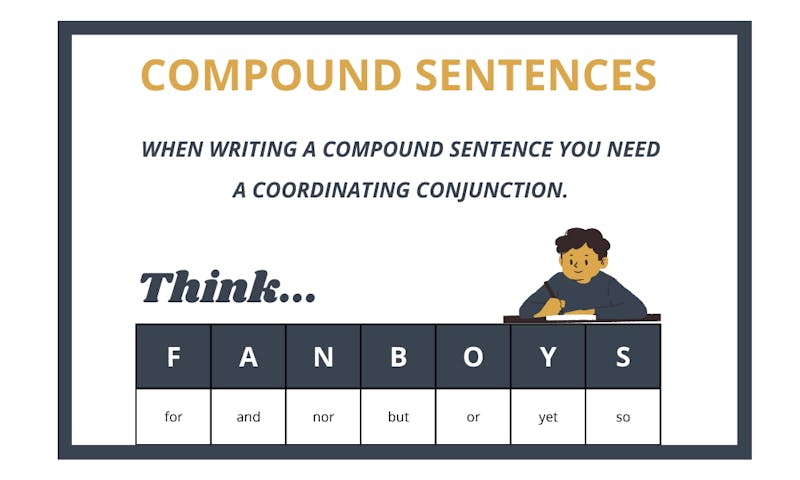Want to spruce up your writing? Compound sentences are pretty important, and they can really help your writing shine.
You’ll want to use compound sentences, which require you to make a few minor adjustments to the structure and punctuation you use, so check out these compound sentence examples, but don't worry; we will explain them along the way!
What is a Compound Sentence?
Sentences are made up of clauses, which are a group of words that have a relationship to each other, along with a subject and a verb. Compound sentences contain two or more independent clauses that share related ideas. You can quickly spot a compound sentence by looking for coordinating conjunctions like “and," "but," or "so" that connect the two clauses or ideas. This is called the FANBOYS rule.
Compound Sentence Examples
Before you head into the FANBOYS rule, familiarize yourself with these compound sentence examples. Pay close attention to the punctuation and coordinating conjunction in bold.
- I really need to go to school, but I’m too sick to sit in class.
- I am trying to save my pocket money, but I really want to go to the movies with my friends.
- He broke his leg, so he had to go to ER.
- She was busy, so I told her I would call back later.
- Dogs are excellent pets, for they are loyal and obedient.
What is the FANBOYS Rule?
There is also an interesting rule regarding FANBOYS that you can use to help you know how to punctuate these sentences. The general rule you want to follow is to put a comma before the conjunction when there are two independent clauses, but sometimes with "and," it's unnecessary.
- Danny took the school bus, and I got a lift. ✅
- Hattie likes painting and reading. ✅
- Mary went to hang out with my friends, and my brother stayed in his room ✅
How do I use Coordinating Conjunctions?
Coordinating conjunctions are simply words that help to create a smooth transition between the two independent clauses. You’ll often hear people use the mnemonic FANBOYS to help them remember when and how to use coordinating conjunctions. FANBOYS stands for the words for, and, nor, but, or, yet, and so.
Fanboy Compound Sentence Examples
- F - For. I can't eat peanuts, for I'm allergic to them. (For explains the reasons why)
- A - And. She takes the school bus, and my mom picks me up. (And connects two ideas)
- N - Nor. Fred didn't ask for help, nor did the teacher give it. (Nor means neither or and not)
- B - But. I want to go home, but my mom has to stay and work. (But means however)
- O - Or. Can I get a hotdog or a cheeseburger? (Or means either)
- Y - Yet. He really didn't want to go to school, yet he went anyway. (Yet means but)
- S - So. Bertie was sick, so he went to the Dr. (So means therefore)
What are Some Examples of Compound Sentences?
Looking at compound sentence examples helps you to start recognizing how you use them in your writing. Most likely, you’ll find that you’ve been using these types of sentences on your own, but being able to know when you make it possible to avoid common mistakes, such as using the wrong type of punctuation.
Flip through these flashcard examples of compound sentences to see if you can spot the independent clauses along with their coordinating conjunctions.
How do I use Semicolons Instead of Conjunctions?
You also have the option of joining the two independent clauses without using a conjunction. If you opt-out of using one of the FANBOYS, then you’ll need to join them with a semicolon.
You can read these compound sentence examples to get familiar with how a semicolon works between two conjunctions.
- Ahmed made a birthday cake; Josiah helped decorate it.
- Libraries are my favorite place to look for books; they have the latest bestsellers there.
- He paid the bill today; his monthly subscription would have ended otherwise.
If you want to use a semicolon and a transitional phrase, you need a conjunctive adverb. Check out how to use them below.
What are Conjunctive Adverbs?
When you use semicolons in compound sentences, you can use conjunctive adverbs to make an even smoother transition. Conjunctive adverbs include the following words.
- however
- meanwhile
- therefore
- besides
- afterward
- at least
- for example
A conjunctive adverb comes after the semicolon. Then, you’ll place a comma after the word that you choose. Here are a few examples of conjunctive adverbs in action.
- It was a grueling marathon; however, Hayley was up to the challenge.
- The area had heavy rainstorms; therefore, no one could drive on the flooded roads.
- You’ll need to pack several important pieces of clothing; for example, you’ll need a heavy coat.
What's the Difference Between a Compound and a Complex Sentence?
It’s pretty easy to confuse compound and complex sentences with each other because they both contain multiple clauses. The easiest way to tell these two sentences apart is to remember that compound sentences have two independent clauses. A complex sentence has one clause that is dependent upon the other. Here’s an example of a complex sentence
- Because I am busy right now, we will proofread your paper later.
In this sentence, the clause, “because I am busy right now,” wouldn’t make any sense without the following portion of the sentence. With a compound sentence, both clauses should be able to make sense on their own.
Writing Compound Sentences Tips & Tricks
Want to improve your writing skills in upper elementary? Look at our tips and tricks.
How do I create compound sentences?
What are 3 types of compound sentences?
How do I practice writing compound sentences?
